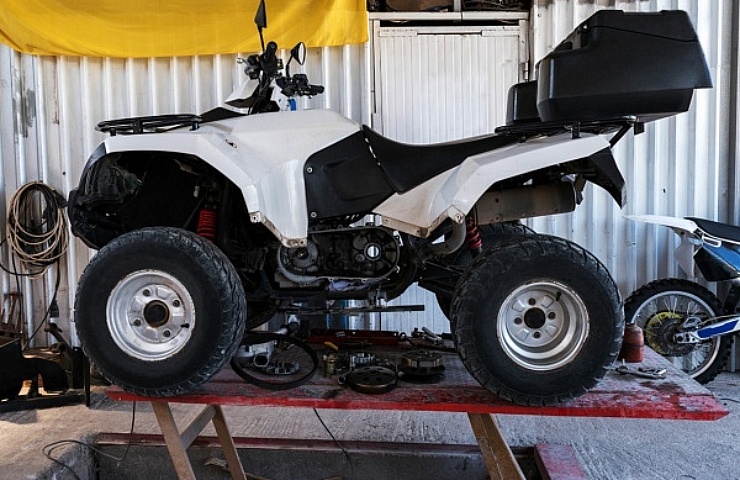Release Your Thrill-Seeking Spirit: ATV Riding Basics for every single Fanatic
Release Your Thrill-Seeking Spirit: ATV Riding Basics for every single Fanatic
Blog Article
ATV Riding Techniques: Grasping the Art of Off-Roading

Body Positioning
To efficiently browse through challenging off-road terrain, it is vital for ATV motorcyclists to constantly keep proper body positioning. Preserving the correct body placement while riding an ATV not just enhances control and stability but likewise guarantees the biker's safety and security. By taking on the right body placing strategies, bikers can efficiently distribute their weight, improve their balance, and lessen the threat of crashes or injuries.
One trick element of proper body positioning is maintaining the feet on the foot secures. Positioning the feet on the foot secures permits the motorcyclist to preserve security and control over the ATV. The rider's knees must be a little bent, offering a minor suspension to absorb shocks and preserve balance. Additionally, the cyclist's upper body must stay relaxed and flexible, enabling quick and seamless activities when essential. This includes maintaining a light grasp on the handlebars to preserve control without excessive force.
Furthermore, the biker's eyes should always be focused in advance, checking the terrain and anticipating any challenges or changes in the trail. By maintaining an onward look, bikers can make split-second choices and react suitably to challenging surface.
Throttle Control
Structure upon the value of correct body positioning for ATV riders, mastering throttle control is a critical skill that allows cyclists to successfully steer with different off-road surfaces. Strangle control refers to the ability to control the quantity of power supplied to the ATV's engine. By understanding exactly how to control the throttle, motorcyclists can make sure a controlled and smooth velocity, permitting them to navigate barriers with precision.
Sudden or jerky activities can trigger the ATV to shed grip or come to be unsteady, making it difficult to preserve control. This method allows the ATV to keep a constant rate and supplies much better grip, reducing the danger of mishaps.
In addition to smooth inflection, cyclists need to likewise learn just how to balance the throttle with various other riding techniques, such as body positioning and stopping. When climbing steep hillsides, motorcyclists require to use enough throttle to preserve energy without subduing the ATV or creating wheel spin. When coming down high inclines, bikers ought to make use of the throttle in mix with appropriate body stopping and positioning to keep control and prevent the ATV from moving or tipping over.

Braking Strategies
An essential facet of ATV riding strategies is understanding effective braking techniques. Recognizing just how to brake properly can make a significant distinction in your safety and control over the automobile when it comes to off-roading. Among the most important braking strategies is using the front brake more than the rear brake. The front brake provides most of the stopping power, so it is crucial to utilize it deliberately. It is vital to bear in mind that extreme stopping with only the front brake can cause the ATV to pitch forward, possibly leading to loss of control or also turning over. It is recommended to use both brakes all at once, yet with more stress on the front brake. Another crucial strategy is to avoid securing the wheels while braking. Securing the wheels can cause skidding, making it hard to preserve control. To stop this, squeeze the brake bars slowly and release them a little if you really feel the wheels locking. By understanding these stopping techniques, you can boost your ATV riding abilities and guarantee a satisfying and safe off-roading experience.
Cornering Techniques
One crucial aspect of grasping ATV riding methods is understanding efficient cornering techniques. Collaring on an ATV can be challenging, yet with the appropriate methods, bikers can browse turns safely and efficiently. The trick to successful cornering is to preserve control of the ATV while taking full have a peek here advantage of traction and reducing the threat of tipping over.
To implement a proper cornering strategy, riders must come close to the turn at a proper rate, ensuring they are not going also sluggish or as well rapid. It is critical to move the body weight in the direction of the within the turn, leaning right into it to keep balance and security. This aids to counterbalance the centrifugal pressure and keeps the ATV upright.
Furthermore, cyclists need to maintain their eyes concentrated on the leave point of the turn instead than the prompt course ahead (ATV). This enables for smoother and much more accurate steering, as it helps the motorcyclist expect any obstacles or modifications in surface
In addition, correct throttle control plays a significant role in cornering. Riders have to regulate the throttle smoothly, avoiding abrupt velocities or decelerations, which can create loss of control.
Uphill and Downhill Riding
When navigating off-road terrain, ATV motorcyclists have to understand the techniques for uphill and downhill riding to keep control and ensure safety and security. Downhill riding, on the various other hand, needs bikers to lean back and change their weight towards the rear of the ATV. By mastering the techniques for uphill and downhill riding, ATV riders can with confidence tackle numerous off-road terrains and delight in a exhilarating and secure adventure.
Conclusion
To conclude, mastering the art of ATV riding calls for a mix of body positioning, throttle control, stopping strategies, and effective cornering. Uphill and downhill riding also require specific abilities to navigate safely. By applying these strategies, bikers can improve their off-roading experience and enhance their general control and safety and security on the ATV.
ATV Riding Techniques: Mastering the Art of Off-Roading is an extensive guide that dives right into the ins and outs of understanding the skills required for off-road ATV riding. Whether you are a beginner or a knowledgeable biker, ATV Riding Techniques: Understanding the Art of Off-Roading supplies vital suggestions to aid boost your off-road ATV riding skills to the following level.

Report this page